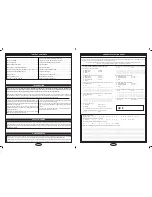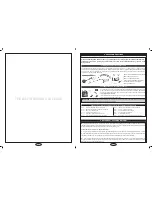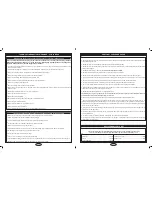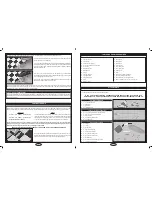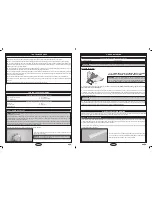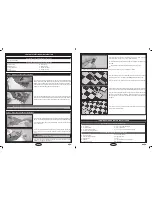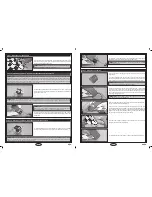
Page 16
Page 5
q
Disconnect the clevis from one elevon control horn, so that the elevon can
be deflected fully in both directions.
q
Remove the protective backing from the covering material. With the elevon
fully deflected in the 'UP' position, place the length of covering material over the
hinge line (on the bottom), making sure that the crease is pushed completely
down into the hinge line.
q
Pivot the elevon up and down several times to check for free movement, then reconnect the clevis to the control horn and repeat
the previous procedures to seal the hinge gap on the second elevon. The elevons should be able to smoothly pivot completely up and
completely down without interference from the covering material.
q
With the elevon fully deflected in the 'UP' position, use a heat-sealing
iron to adhere the covering material to both the trailing edge of the wing and
to the leading edge bevel of the elevon.
q
Either trim the excess covering material flush with both surfaces or iron it
down onto the wing and the elevon, as shown.
+
Only the bottom of the hinge gap needs to be sealed. It is not necessary to seal both the bottom and the top.
It is very important that you understand throttle management. Basically, this means no full throttle dives. Full throttle dives should be
avoided so as not to cause control surface flutter and/or airframe failure. When the nose of the aircraft drops, decrease the throttle, just
as in full-scale aircraft.
STeP 2: ThroTTle MANAGeMeNT
Ailerons: 3/8" (10mm) up and down
elevator: 3/8" (10mm) up and down
Reflex: Both Elevons 1mm Up
Test Flying
The conTrol Throws are measured aT The ouTer Tip oF The conTrol surFaces
We recommend initially setting up the aircraft using the Test Flying control throws. These control throws are suggested for initial test flying
because they will allow the aircraft to fly smoother and make it easier to control. You can increase the control throws to suit your flying
style, but only AFTER you've become very familiar with the flight characteristics of the aircraft using the Test Flying control throws.
CoNTrol ThroWS
The control throws listed are a good starting point for test flying and general sport flying. Of course, you can adjust these
control throws to suit your particular style and tastes, but realize that the aircraft will be extremely control sensitive and more
difficult to control with higher control throws, particularly at high speeds.
q
After you're finished adjusting the control throws, you need to cut two 1/4"
(6mm) lengths of silicone fuel tubing and slide one piece over each clevis. The
tubing will prevent any chance of the clevises opening during flight.
Reflex
The aircraft requires approximately 1mm of Reflex (both control surfaces up)
for neutral. To set the Reflex, centre both elevons with the wing tips, then adjust
the pushrods so that both elevons are 1mm up from centre. This is the neutral
point and should be the point where the control throws are measured.
q
220 Grit Sandpaper
q
Sanding Block
q
Masking Tape
q
Paper Towels
q
Rubbing Alcohol
q
Epoxy Mixing Sticks
q
Epoxy Mixing Cups
q
Soldering Iron
q
Solder
q
Heat-Shrink Tubing (Assorted Sizes)
q
Heat Gun (for Heat-Shrink Tubing)
q
Heat Sealing Iron (for Covering Material)
q
White Covering Material 1/2" x 24" (1.3cm x 61cm)
q
5 Minute Epoxy
q
Thin and Thick C/A
q
C/A Debonder
q
Formula 560 Canopy Glue
q
# 1 and # 2 Phillips Head Screwdrivers
q
Wire Cutters
q
Needle Nose Pliers
q
Modeling Knife
q
Scissors
q
Electric or Hand Drill
q
Assorted Drill Bits
q
Straight Edge Ruler
q
Pencil
q
Builder's Triangle
Before you begin assembly, group the parts as we list them below. This will ensure that you have all of the parts before you begin assembly
and it will also help you become familiar with each part.
iF you Find any parTs missing or damaged, please conTacT your local model Tech
dealer direcTly, using The separaTe cusTomer service sheeT included wiTh your kiT.
q
(1) Wing with Hatch Cover
q
(1) Right Elevon
q
(1) Left Elevon
q
(2) Vertical Stabilisers
q
(2) 5-3/4" (146mm) Threaded Wires with Z-Bends
q
(2) Nylon Control Horns with Backplates
q
(2) Nylon Clevises
q
(6) M2 x 16mm Machine Screws
q
(6) C/A-Style Hinges
q
(1) Cowling
q
(1) Canopy
q
(1) Landing Skid
q
(2) Plywood Spacer Plates
q
(1) Hook and Loop Material
q
(4) M3 x 12mm Machine Screws
q
(4) M3 x 18mm Machine Screws
q
(4) M3 Flat Washers
q
(4) M2 x 10mm Washer-Head Wood Screws
q
(1) Decal Sheet (Not Pictured)
KiT CoNTeNTS
AirFrAMe ASSeMblieS
CoNTrol SySTeM ASSeMblieS
MiSCellANeouS PArTS
ToolS ANd SuPPlieS reQuired


